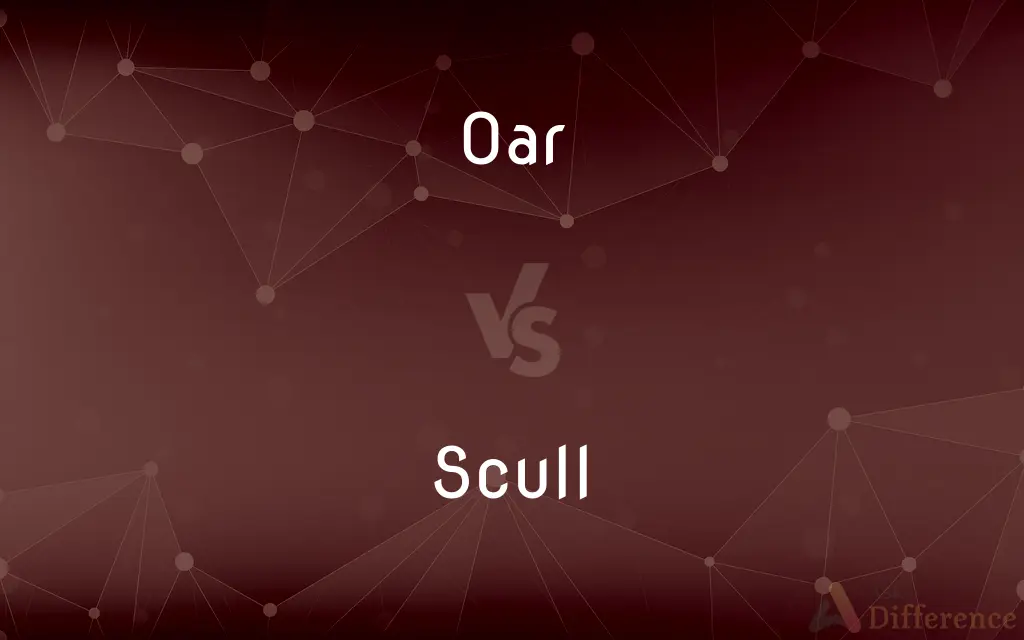Oar vs. Scull — What's the Difference?
By Tayyaba Rehman & Fiza Rafique — Updated on May 1, 2024
An oar is used for rowing, typically involving one blade attached per oar, while a scull refers to a type of oar with two blades or a boat used in sculling.

Difference Between Oar and Scull
Table of Contents
ADVERTISEMENT
Key Differences
An oar is a basic tool used in rowing boats, comprising a long shaft with a flat blade on one end, used to propel the boat through water. Sculls, on the other hand, are lighter and smaller oars with each rower using two, one in each hand, allowing for a different technique in rowing.
Oars are usually part of rowing where each rower controls one oar with both hands. Sculls are used in sculling, a form of rowing where each rower uses two sculls, enhancing their control and stroke efficiency.
In terms of boat design, oars are used on wider boats that require more stability and accommodate more rowers, such as those used in crew. Sculls are typically associated with narrower, single-person boats that are lighter and faster.
The technique in using oars involves pushing against the water in a more traditional rowing format, where teamwork and synchronization are crucial. Sculling, however, emphasizes individual skill and technique, with a focus on balance and fine motor control.
Oars and the boats they are used with are generally geared towards team events and larger vessels, suitable for regattas and team racing. Sculls cater to individual rowers or smaller teams, often seen in competitive solo and dual events.
ADVERTISEMENT
Comparison Chart
Number of Blades
One blade per oar
Two blades, one per hand
Usage in Boats
Used in wider, team-oriented boats
Used in narrower, single or dual-person boats
Technique
Both hands on one oar
One hand per scull
Control and Stroke
Requires coordination and strength
Allows for more precise control and faster strokes
Event Type
Suited for team events
More common in solo or dual events
Compare with Definitions
Oar
Requires both hands to manipulate effectively.
Rowers coordinate their hands in unison to maneuver the oar.
Scull
A type of oar used in sculling, having two blades.
She adjusted her grip on the sculls as she prepared to row.
Oar
Used primarily in traditional rowing.
The team practiced with their oars daily at dawn.
Scull
Suitable for solo or small team competitions.
Scull events often highlight the prowess of individual rowers.
Oar
Integral to crew-based sports.
Each oar in the boat is crucial for the team's success.
Scull
Allows for individual rowing in sport.
He competes in the single sculls category.
Oar
A long pole with a flat blade, swung on pivots in rowing.
He grabbed the oar firmly to steady the boat.
Scull
Each scull is managed by one hand.
Precision in scull handling dictates the boat’s speed.
Oar
Associated with larger, more stable boats.
Oars are essential for maintaining the balance of large rowing boats.
Scull
Linked with high-speed, competitive rowing.
Sculls are preferred for their agility and fast pacing in races.
Oar
An oar is an implement used for water-borne propulsion. Oars have a flat blade at one end.
Scull
Each of a pair of small oars used by a single rower.
Oar
A pole with a flat blade, used to row or steer a boat through the water
She pulled hard on the oars
Scull
A large group of fish which has migrated from the open sea to inshore waters.
Oar
Propel with or as if with oars; row
Oaring through the weeds
Oaring the sea like madmen
Scull
Propel a boat with sculls
He built boats and taught the gentlemen how to scull
Oar
A long, thin pole with a blade at one end, inserted into an oarlock and used to row or steer a boat.
Scull
A long oar used at the stern of a boat and moved from side to side to propel the boat forward.
Oar
A person who rows a boat, especially in a race.
Scull
One of a pair of light oars designed for use by a single rower.
Oar
To propel with or as if with oars or an oar.
Scull
A small light racing boat for one, two, or four rowers, each using a pair of sculls.
Oar
To traverse with or as if with oars or an oar
An hour to oar the strait.
Scull
To propel (a boat) with a scull or a pair of sculls.
Oar
To move forward by or as if by rowing
Oared strongly across the finish line.
Scull
To use a scull or a pair of sculls to propel a boat.
Oar
An oarsman; a rower.
He is a good oar.
Scull
To generate propulsion, as in swimming, with a motion resembling that of a single scull oar.
Oar
(zoology) An oar-like swimming organ of various invertebrates.
Scull
A single oar mounted at the stern of a boat and moved from side to side to propel the boat forward.
Oar
(literary) To row; to travel with, or as if with, oars.
Scull
One of a pair of oars handled by a single rower.
Oar
An implement for impelling a boat, being a slender piece of timber, usually ash or spruce, with a grip or handle at one end and a broad blade at the other. The part which rests in the rowlock is called the loom.
Scull
A small rowing boat, for one person.
Oar
An oarsman; a rower; as, he is a good oar.
Scull
A light rowing boat used for racing by one, two, or four rowers, each operating two oars (sculls), one in each hand.
Oar
An oarlike swimming organ of various invertebrates.
Scull
Obsolete form of skull
Oar
To row.
Oared with laboring arms.
Scull
A skull cap. A small bowl-shaped helmet, without visor or bever.
Oar
An implement used to propel or steer a boat
Scull
(obsolete) A shoal of fish.
Scull
The skua gull.
Scull
To row a boat using a scull or sculls.
Scull
To skate while keeping both feet in contact with the ground or ice.
Scull
To drink the entire contents of (a drinking vessel) without pausing.
Scull
The skull.
Scull
A shoal of fish.
Scull
A boat; a cockboat. See Sculler.
Scull
The common skua gull.
Scull
To impel (a boat) with a pair of sculls, or with a single scull or oar worked over the stern obliquely from side to side.
Scull
To impel a boat with a scull or sculls.
Scull
A long-handled oar mounted at the stern of a boat and moved left and right to propel the boat forward
Scull
One of a pair of short-handled oars
Scull
A racing shell propelled by one or two oarsmen pulling two oars
Scull
Propel with sculls;
Scull the boat
Common Curiosities
How do rowers choose between using oars or sculls?
The choice depends on the type of boat, the number of rowers, and the race category.
What is the main difference between an oar and a scull?
An oar has one blade and is used with both hands, whereas a scull has two blades and each is used with one hand.
Are oars and sculls interchangeable in rowing?
No, they require different techniques and are typically not interchangeable.
Which is faster for racing, oars or sculls?
Sculls tend to be faster due to their lighter weight and the technique used.
Is it easier to learn rowing with oars or sculls?
Learning with oars might be initially easier due to the stability of the larger boats they are used in.
What type of water bodies are suitable for sculls?
Sculls are best used in calm waters, as they are lighter and more susceptible to tipping.
What skills are necessary for sculling effectively?
Balance, precision, and fine motor control are essential for sculling.
What are the common competitions for oar-based and scull-based rowing?
Oar-based rowing is common in university and large team regattas, while scull-based rowing features in Olympic and solo events.
What materials are used to make oars and sculls?
They are typically made from wood, fiberglass, or carbon fiber for strength and lightweight.
How does the blade of an oar compare to that of a scull?
The blade of an oar is larger and designed for deeper, stronger strokes.
Can you use sculls in a team boat?
Yes, sculls can be used in team boats, typically in pairs or quads.
How do the costs of oars and sculls compare?
Sculls can be more expensive due to their specialized design and materials.
Are there different sizes of oars and sculls?
Yes, both oars and sculls come in various lengths and sizes to suit the rower and boat type.
How does the technique of rowing change with the type of oar?
The technique changes significantly, with oar rowing focusing on power and team coordination, while sculling focuses on rhythm and individual technique.
Can children use the same oars and sculls as adults?
No, children use smaller, lighter oars and sculls appropriate for their size.
Share Your Discovery

Previous Comparison
However vs. Otherwise
Next Comparison
Always vs. WheneverAuthor Spotlight
Written by
Tayyaba RehmanTayyaba Rehman is a distinguished writer, currently serving as a primary contributor to askdifference.com. As a researcher in semantics and etymology, Tayyaba's passion for the complexity of languages and their distinctions has found a perfect home on the platform. Tayyaba delves into the intricacies of language, distinguishing between commonly confused words and phrases, thereby providing clarity for readers worldwide.
Co-written by
Fiza RafiqueFiza Rafique is a skilled content writer at AskDifference.com, where she meticulously refines and enhances written pieces. Drawing from her vast editorial expertise, Fiza ensures clarity, accuracy, and precision in every article. Passionate about language, she continually seeks to elevate the quality of content for readers worldwide.
















































